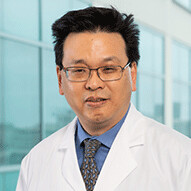Pediatric stem cell transplant
Stem cell transplants are used to treat certain diseases, including some cancers, by replacing unhealthy cells with healthy stem cells.
What is a pediatric stem cell transplant?
Stem cells are the basic cell and foundation for every organ and tissue in the body. Stem cells are “unspecialized” cells, which means they don’t have a specific body function. However, stem cells have the potential to become specialized cells. They can divide, copy and renew themselves over time.
Patients can receive healthy cells (stem cells) to replace bone marrow cells destroyed by diseases like cancer, or treatments like radiation or chemotherapy. Stem cell transplants can come from a donor (allogeneic) or the patient (autologous).
Types of stem cell transplants
Stem cell transplants can come from a donor or the patient, and healthy stems cells can be taken from various parts of the body.
Allogeneic transplants - Allogenic cells come from a donor. They are used for patients who are at risk of cancer coming back (relapse), have relapsed or don’t respond to treatment. A sibling or other relative can provide stem cells, or they can come from a donor on the bone marrow registry.
Patients run the risk of rejecting these stem cells because they are foreign to the body. However, because they come from a donor, the new stem cells can also recognize cancer cells as foreign and destroy them.
This type of transplant can treat blood cancers, such as leukemia, lymphomas and multiple myeloma (cancerous plasma cells), as well as bone marrow disorders or cancers.
Autologous transplants - Autologous cells come from a patient themselves, by collecting bone marrow before a child is treated for cancer and stem cells are frozen for later use. After these patients undergo high-intensity chemotherapy or radiation to kill cancer cells, the healthy stem cells are returned to the body. Because the cells come from the patient, the body will not reject them.
This type of stem cell transplant is used to treat leukemia, lymphomas and multiple myeloma. It can also be used to treat testicular cancer and neuroblastoma, which is a type of cancer that starts in early forms of nerve cells.
Types of stem cells
Stem cells are typically taken from the following areas for transplant:
Bone marrow transplant (BMT) - A physician removes marrow from a donor’s hip bone.
Peripheral blood stem cell transplant - This is the most common source of stem cell transplant. The cells come from the bloodstream.
Cord blood transplant - Cord blood stem cells are taken from the umbilical cord and placenta after a baby is delivered.
Pediatric stem cell transplant doctors and providers
 Victor Aquino, MDPediatric Hematologist/Oncologist
Victor Aquino, MDPediatric Hematologist/Oncologist Kathryn E. Dickerson, MDPediatric Hematologist/Oncologist
Kathryn E. Dickerson, MDPediatric Hematologist/Oncologist Jessica Garcia, MDPediatric Hematologist/Oncologist
Jessica Garcia, MDPediatric Hematologist/Oncologist Andrew Koh, MDPediatric Hematologist/Oncologist
Andrew Koh, MDPediatric Hematologist/Oncologist Kathleen Ludwig, MDPediatric Hematologist/Oncologist
Kathleen Ludwig, MDPediatric Hematologist/Oncologist Ksenya Shliakhtsitsava, MDPediatric Hematologist/Oncologist
Ksenya Shliakhtsitsava, MDPediatric Hematologist/Oncologist Tiffany Simms-Waldrip, MDPediatric Hematologist/Oncologist
Tiffany Simms-Waldrip, MDPediatric Hematologist/Oncologist Sisi Zheng, MDPediatric Hematologist/Oncologist
Sisi Zheng, MDPediatric Hematologist/Oncologist